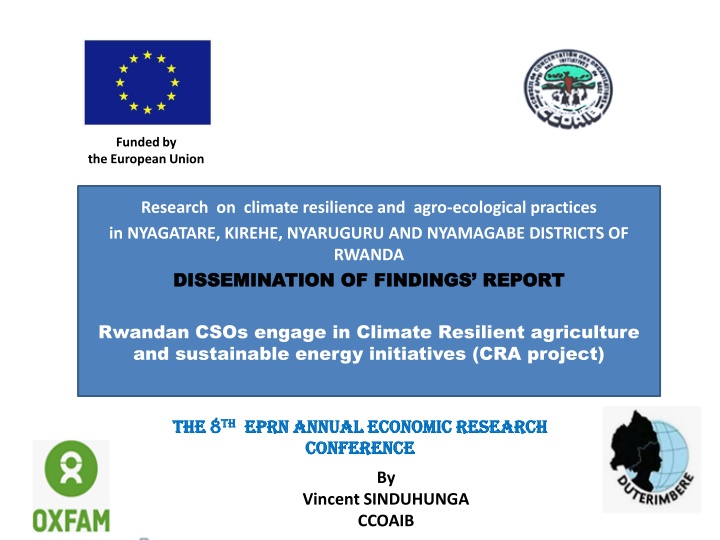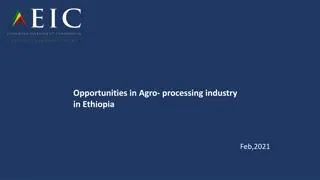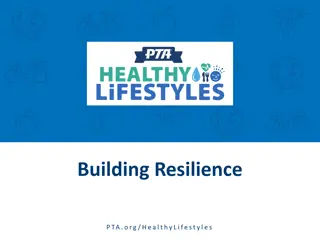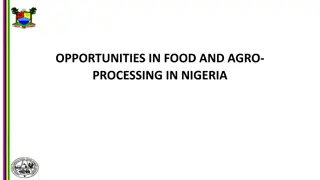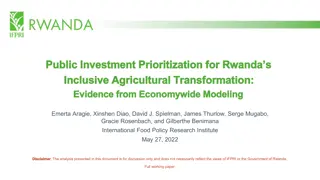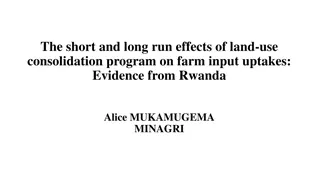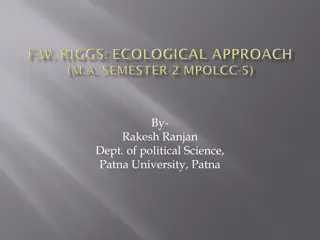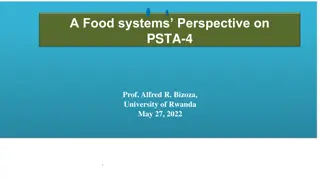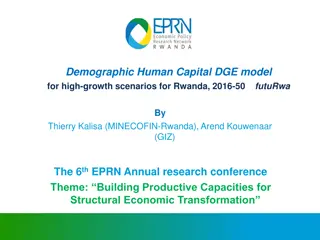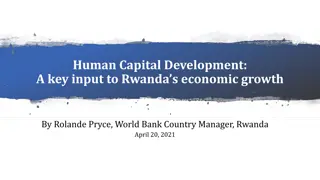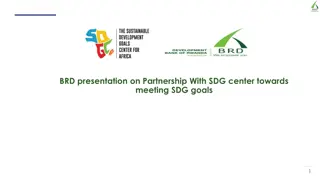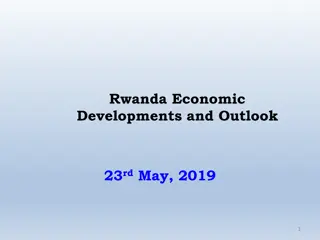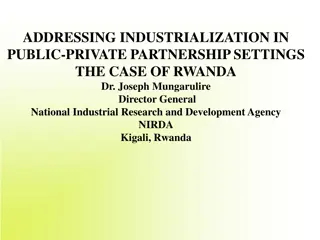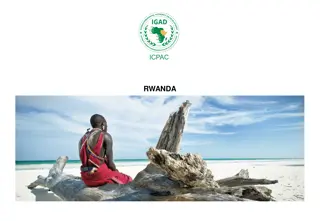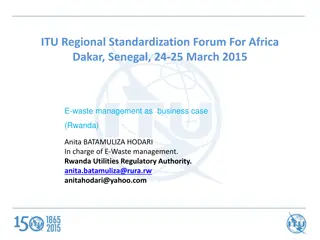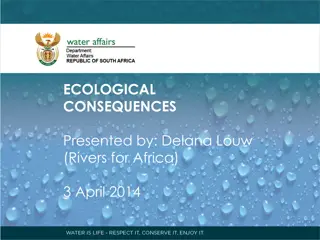Research on Climate Resilience and Agro-ecological Practices in Rwanda
This research project focuses on climate resilience and agro-ecological practices in Nyagatare, Kirehe, Nyaruguru, and Nyamagabe districts of Rwanda. Led by a consortium including CCOAIB, OXFAM, and Duterimbere NGO, the study aims to promote sustainable agriculture and energy initiatives. Through a comprehensive research framework and sample population, the project explores the adoption of agroecology and sustainable food-energy systems to address climate change challenges. The findings and policy implications aim to enhance agricultural sustainability and resilience in Rwanda.
Download Presentation

Please find below an Image/Link to download the presentation.
The content on the website is provided AS IS for your information and personal use only. It may not be sold, licensed, or shared on other websites without obtaining consent from the author.If you encounter any issues during the download, it is possible that the publisher has removed the file from their server.
You are allowed to download the files provided on this website for personal or commercial use, subject to the condition that they are used lawfully. All files are the property of their respective owners.
The content on the website is provided AS IS for your information and personal use only. It may not be sold, licensed, or shared on other websites without obtaining consent from the author.
E N D
Presentation Transcript
Funded by the European Union Research on climate resilience and agro-ecological practices in NYAGATARE, KIREHE, NYARUGURU AND NYAMAGABE DISTRICTS OF RWANDA DISSEMINATION OF FINDINGS REPORT DISSEMINATION OF FINDINGS REPORT Rwandan CSOs engage in Climate Resilient agriculture and sustainable energy initiatives (CRA project) THE 8 THE 8th th EPRN Annual Economic Research EPRN Annual Economic Research Conference Conference By Vincent SINDUHUNGA CCOAIB
RESEARCH CONCEPTUAL FRAMEWORK Public institutions (Public Policies and strategies) Non State actors (skills and information) Farmers AEPs adoption (knowledge and adoption) Sustainable food- energy system
INTRODUCTION Research title Research on climate resilience and agro-ecological practices Period June to October 2021 Owner Consortium led by CCOAIB including OXFAM and Duterimbere NGO Research team Mr. Raphael Rurangwa (Team Leader) Dr. Pascal Rushemuka , Dr. Alain Ndoli Mr. Rumenera Philippe Scope Country: Rwanda Districts: Nyamagabe and Nyaruguru (Southern Province) Kirehe and Nyagatare (Eastern province) Focus: Agroecology, Climate resilient practices and Food-energy system Approaches and Sample population Quantitative and qualitative approaches 400 HH (random sample) 20 KIs (at national and district level) + 8 FGDs
WHY AGROECOLOGICAL PRACTICES (AEPs)? Current regain of interest of agroecological practices is motivated by: Unsustainability of the current food production system (recognized to be a major contributor to climate change) Pressing need to achieve resilient agriculture compatible with climate change adaptation.
AEPs and FOOD SYSTEM Energy is directly and indirectly embedded in food production and preparation FAO. (2014) It is estimated that at a global level, food production and its supply chain consume about 30% of total energy (FAO s water, food, energy nexus, 2014). However, Agro-ecological practices can present a good opportunity to address the concern for energy to be used in this sector. This can be done through integrating tree, crop, livestock, biogas and solar energy
POLICY FRAMEWORK The findings from policies review have revealed that the agroecology and climate resilient aspects are considered at policy level. The concern for agriculture sustainability coupled with the urgent need for addressing the issues of climate change are the main drivers for integration of agroecology, climate resilient and food energy practices development policies into key national
NON STATE ACTORS VIEWS Lack of promotion of the EAPs in actual farming system Lack of evidence-based recommendations from the research demonstrating the impact and benefits of the EAPs, which would inform and motivate farmers to adopt the EAPs Current climate change and agroecology policies are not well known among the communities
PUBLIC INSTITUTIONS There is limited enforcement of the conservation agriculture or AEPs There is no inclusion of EAPs in the performance contracts for agronomists Policy dialogues would enhance adoption of the AEPs
AEPs ADOPTION BY FARMERS 14.3% of respondents were found with required knowledge, 14% had used agroecological practices in the last 10 years, 13.9% were still applying the practices at the time of interviews (i.e. year 2021). If adequate knowledge is provided to farmers, adoption rates are expected to be high and consistent.
AEPs ADOPTION BY FARMERS In terms of knowledge and practice, results have shown that top 5 high ranked AEPs in the decreasing order are: Crop rotation, Organic fertilizers, Land terracing, Agroforestry, and Eco-friendly chemical fertilizers. The lowest ranked AEP were cultural, biological control, and push and pull.
ADVANTAGES OF USING THE AEPs Increased level of adaptation to CC effects 4 8 12 5 Decreased incidence of crop pest and diseases 32 24 19 9 Reducti on of losses to farmers Improved crop productiv ity Increas ed soil fertility Improved soil water retention Improvem ent in HH nutrition % of HH AEPs Crop rotation Organic fertilizers Agroforestry Terracing Eco friendly chemical fertilizers Contour Planting Cover crops/mulches Recycled harvested rain water Conservation on tillage 19 Intercropping 178 185 65 56 235 198 44 69 33 84 60 56 158 116 40 39 34.2 32.9 12.8 12.5 47 79 11 33 1 3 9.3 33 52 30 40 44 32 16 13 15 4 19 13 8.4 8.2 18 27 17 17 2 3 4.5 18 18 17 5 16 7 5 4.2 4 11
Farmers preference of AEP in Nyamagabe, Nyaruguru, Kirehe, and Nyagatare Districts Crop rotation Organic fertilizers Terracing Agroforestry Eco friendly chemical fertilizers Cover crops/mulches Contour Planting Use of SSIT Equipment's Valley tank/dam Preference in AEPs Intercropping Conservation on tillage Recycled harvested rain water Green manure plants Crop insurance Use of weather and climate information Eco friendly chemical pesticides Mixed crop (Beans or Soya beans) Biological control Farm ponds small scale irrigation Mechanical and physical control Cultural control Climate smart post-harvest value addition Natural pesticides and anti-weeds such as push and pull 0 50 100 150 200 250 300 Number of farm households Kirehe Nyagatare Nyamagabe Nyaruguru
MITIGATION MEASURES TO ADDRESS FARMING PRACTICES CHALLENGES Mitigation measures Frequency % Supplementary irrigation 77 24.7 Adapted crops 86 27.6 Earlier varieties Crop diversification maturing crop 76 24.4 10 3.2 Rearing livestock 12 3.8 Practicing activities off farm 88 28.2
CONCLUSION Rwandan climate change and agroecology related policies are well developed Climate change effects are negatively impacting small holder farmers Agroecology is not well known and adopted by smallholder farmers Farmers praised to promote (i) crop rotation, (ii) organic fertilizers, (iii) terracing, (iv) agroforestry, and (v) eco-friendly chemical fertilizers. Farmers recommend only what they know and have experienced. Additional AEPs could be welcomed if proper extension is provided
CONCLUSION Firewood is the most dominant source of cooking energy in rural areas (97% of households) seconded by crop residues (22.4% of households) Charcoal was the first source in urban areas (55.6%) seconded by firewood (49.5%). Compared to Eastern province, districts in the southern province (Nyamagabe and Nyaruguru) do not have adequate access to LPG (Gas)
RECOMMENDATIONS POLICY LEVEL To institutionalize the AEPs for its scaling up (MINAGRI and MoE); To develop a solid extension system for AEPs that goes hand in hand with the existing extension system for CIP to harmonise Crops productivity and soil conservation (MINAGRI & Districts).
RECOMMENDATIONS IMPLEMENTATION LEVEL To promote AEPs through extension and action research approaches (RAB, districts, CSOs and FOs)); To advocate for the effective enforcement with incentives of AEPs (CSOs and FOs); To support farmers to develop agroecological products markets for premium prices (Minicom, MINAGRI, Districts, PSF and CSOs and FOs).
You can access detailed findings report on: www.ccoaib.org www.urubuga.org
MURAKOZE CYANE MURAKOZE CYANE THANK YOU VERY MUCH THANK YOU VERY MUCH MERCI MERCI BEAuCOUP BEAuCOUP
